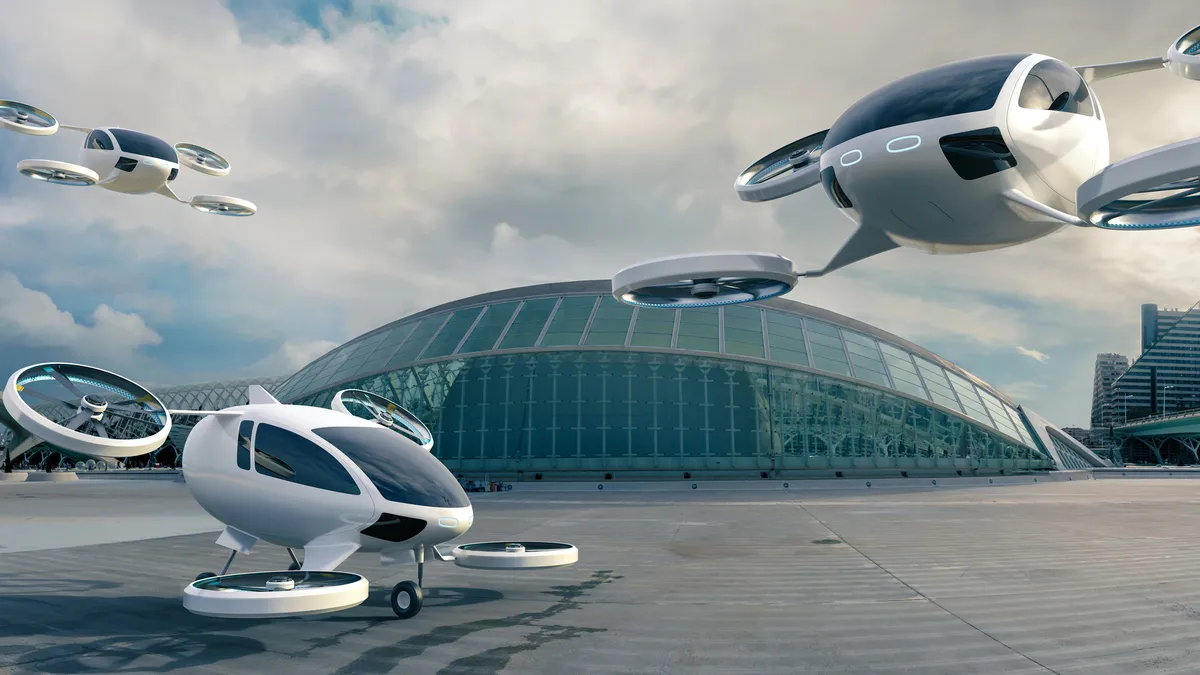Electric vertical take-off and landing (eVTOL) vehicles, or what have come to be known as flying taxis, could be the next wave of advanced air mobility, but along with infrastructure questions — can the electric grid handle the demand of air taxis — jurisdictional fights over governance stand in the way.
“One of the major concerns is encapsulated by the word federalism,” Timothy Ravich, senior counsel at Tressler Law and an associate professor at the University of Central Florida, told Legal Dive. “Lawmakers at the local level may be interested in passing laws or passing ordinances that either allow or disallow flying taxis, but those laws may end up getting preempted by federal law.”
eVTOLs are distinguished from helicopters by their low cost, quiet operation, low carbon impact and the ability to land and take off in ultra small spaces. They’re already a $6.9 billion business, according to 2021 figures by Acumen Research and Consulting, mainly through institutional use by the military and search and rescue squads. Some industries use them for supply chain logistics. The industry is expected to reach $30.5 billion by 2030, Acumen says.
But champions of eVTOLs see them as especially attractive for short hops around cities by commuters wanting to get out of traffic — and that puts air space battles at the center of industry ambitions.
“Regulators [need] to think about new corridors — new roads in the sky, if you will,” Ravich said.
If a city wants to build a vertiport — an eVTOL take-off and landing site — in their downtown area, for example, they could probably do that. “The federal government really has no say there,” Ravich said. “But if you want to fly a taxi from that vertiport and enter national airspace, then the federal government may get involved and may try to preempt or trump state law.”
The Federal Aviation Administration has jurisdiction over airspace starting at 500 feet above the ground, Ravich said, but in recent years the agency has been trying to stake out a role in the airspace beneath that.
“Since the advent of drones,” he said, “the FAA has increasingly taken the position that they have jurisdiction ‘above the grass’ — the area under 500 feet. [That] is now increasingly becoming an area in which local and federal lawmakers are jockeying for jurisdiction.”
Other federal agencies are likely to assert their authority as well, setting up jurisdictional battles among NASA, Homeland Security, Energy, Transportation and the Air Force. Tribal governments would also be expected to step in.
Air space isn’t the only unsettled legal area; how eVTOLs are defined can open up another can of worms, Kent Jackson, managing partner at JetLaw, said.
There's a lot of concern among regulators how these aircraft are defined and who should be allowed to fly what, he said.
“Are we going to define these aircraft in a way that opens up the pilot pool?” he said. “For example, if we define the aircraft as something other than a helicopter, do we limit the pool of available pilots? That's an issue that’s not over until it’s over.”
In June, the U.S. Department of Transportation published a request for Information on advanced air mobility. It’s seeking public comment on a number of topics, including the legal and policy framework required before commercial eVTOLs can operate. The closing date on the comment period was Aug 16. Hundreds of comments were received.
The general consensus among those who fly and build aircraft is there’s a great deal of work to do be done before flying taxis can be commercialized at scale.
“Continued development of comprehensive regulations specifically tailored to [advanced air mobility] is essential,” the National Aviation Association said. “Updating existing regulations to address airspace integration challenges posed by AAM is crucial — specifically for scaled operations. Addressing infrastructure-related challenges through legal authorities will be critical for successfully integrating AAM into existing transportation systems.”
In addition to air rights, legal battles with electricity boards also loom; eVTOLs will create demand that electrical grids aren’t yet prepared to handle.
“When we think of an electric propulsion future as it stands today, we're missing a lot of the infrastructure required to deliver the amount of electricity needed,” including stations for super fast charging, Jackson said.
“The electric power grid will require upgrades in many areas and it’s expected that vertiports and eVTOL charging stations will require the biggest electric loads that a utility currently serves,” he said.
To get a sense of what’s ahead, industry specialists will be looking at what happens in Paris next year and Los Angeles in 2028. Governments, Olympics organizers and other interested parties are hoping to prototype eVTOLs as urban taxis in both of those cities. How those plans and the broader legal battles pan out will be closely watched.



















